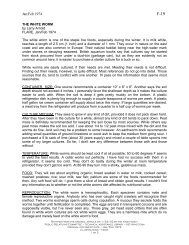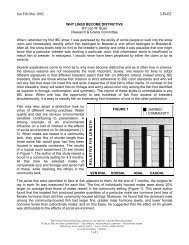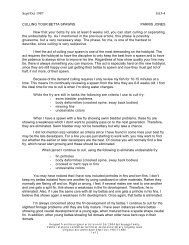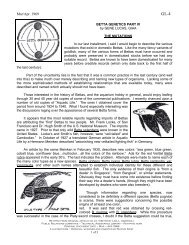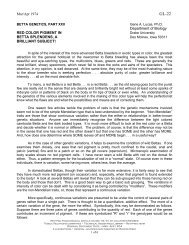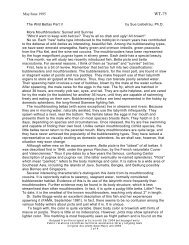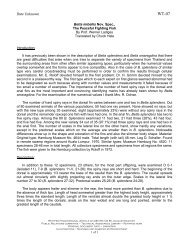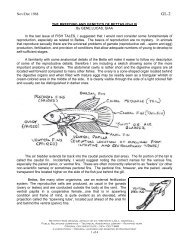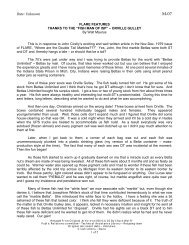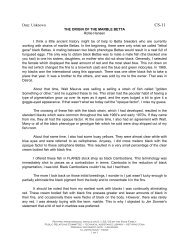WT-71: The Wild Bettas â Part 1 - International Betta Congress
WT-71: The Wild Bettas â Part 1 - International Betta Congress
WT-71: The Wild Bettas â Part 1 - International Betta Congress
You also want an ePaper? Increase the reach of your titles
YUMPU automatically turns print PDFs into web optimized ePapers that Google loves.
March/April 1994<br />
<strong>WT</strong>-<strong>71</strong><br />
<strong>The</strong> <strong>Wild</strong> <strong><strong>Betta</strong>s</strong> – <strong>Part</strong> 1<br />
By Sue Liebetrau, Ph.D.<br />
Introduction<br />
“What is a <strong>Betta</strong>?” Obvious, you answer, it’s a lovely red, green, or purple creature sailing<br />
majestically across its bowl or aquarium.<br />
“Ah, but a <strong>Betta</strong> is more than that.” Okay, you say, it’s a labyrinth fish; it doesn’t need aerated<br />
water; and it spawns under a bubble nest.<br />
tails.<br />
“More than that.” Well, <strong><strong>Betta</strong>s</strong> come in almost every color of the rainbow, and some have two<br />
“Even more.” Hmmm. Oh — you guess, that there are more than one species of <strong>Betta</strong>.<br />
“More.” Some are mouthbrooders.<br />
“And…?”<br />
If you have run out of responses by now, you are not unlike the majority or hobbyists. Even<br />
those for whom the study or <strong><strong>Betta</strong>s</strong> is a profession confess to much ignorance about this interesting<br />
genus of labyrinth fishes. Over the past century and a half, knowledge has accumulated slowly. <strong>The</strong>re<br />
have been small steps, false steps, and some giant steps. Many of the largest have been taken in very<br />
recent times. Most of the published information is already obsolete.<br />
This article represents the first in a series. Based on information currently available, five are<br />
planned. A sixth will be added if circumstances warrant it. In the series, I will attempt to summarize<br />
and correlate for you the current information from the study of wild <strong><strong>Betta</strong>s</strong>. I will describe the kinds of<br />
<strong><strong>Betta</strong>s</strong> currently available to aquarists and also a few which have been or will be obtainable. Tricks of<br />
keeping these fish, as well as spawning techniques, will be included. Various hypotheses as to the<br />
number of species will be advised of the Progress of the <strong>International</strong> <strong>Betta</strong> <strong>Congress</strong> Species<br />
Maintenance Program (SMP), now in the planning stages. Through that program, you should be able<br />
to obtain most of the wild <strong><strong>Betta</strong>s</strong> currently spawned.<br />
Before delving into the study of wild <strong><strong>Betta</strong>s</strong>, we should briefly examine the basic <strong>Betta</strong>. <strong><strong>Betta</strong>s</strong><br />
belong to the labyrinth fishes. <strong>The</strong> suborder is Anabantoidei, and the family is Belontiidae. A<br />
subfamily, Belontinnae, includes the Belontia genus. A second subfamily, Trichogasterinae, includes<br />
many of the gouramis. <strong>The</strong> genus <strong>Betta</strong> is in a third subfamily, the Macropodinae, along with the<br />
paradise fishes, croaking gouramis, and Ctenops, Malpulutta, and Parosphromenus genuses. <strong>The</strong><br />
term <strong>Betta</strong> was coined by Bleeker in 1850, when the first <strong><strong>Betta</strong>s</strong> were originally described.<br />
<strong><strong>Betta</strong>s</strong> are small fishes; the largest known individuals (mouthbrooders) do not exceed 6”. <strong>The</strong>y<br />
are slender, with tapering bodies. <strong>The</strong>y posses three unpaired fins (dorsal, caudal, and anal) and two<br />
pairs of fins, pectoral and pelvic (ventral). <strong>The</strong>y have small teeth and are carnivores.<br />
<strong>The</strong> internal organ of major interest is the labyrinth. Two passages lead from the mouth up<br />
behind the eyes, over the gills, possibly eventually to the swim bladder. As a <strong>Betta</strong> gulps air at the<br />
surface of the water, oxygen is transmitted through these passages to the blood vessels. <strong>The</strong> labyrinth<br />
Retyped From Original Article on 08/12/02 By Ralph Tran<br />
Public Relations committee ~ Technical Assistance Library ~ Retyping team<br />
Original document date ~ March/April 1994<br />
Illustrations ~ None<br />
1 of 5
March/April 1994<br />
<strong>WT</strong>-<strong>71</strong><br />
is basic to the <strong>Betta</strong>’s ecological position. Because the fish is not dependent upon oxygen-rich water, it<br />
can thrive in slow or stagnant, shallow ponds or puddles.<br />
Those species which live in still, swampy waters–even in the shallow footprints of water buffalo–<br />
build a nest of sticky bubbles at the surface of the water. This nest is usually constructed under some<br />
protective cover like a floating leaf (or, in domestic situations, a plastic lid). It may be skimpy or<br />
luxurious; it is home for the tiny fry. <strong>The</strong>se hatch from eggs placed in the nest by the male <strong>Betta</strong>, who<br />
then cares for them.<br />
<strong>The</strong> spawning sequence of all <strong><strong>Betta</strong>s</strong> consists of a series of embraces, during which the male<br />
wraps himself around the female. <strong>The</strong> eggs are released from her abdominal area and fertilized. <strong>Betta</strong><br />
eggs sink (those of some labyrinth fishes float to the surface), and the male bubblenester must pick<br />
them up, place them in the nest, and care for them. <strong>The</strong> tiny fry, hatching about thirty-six hours after<br />
the spawning process, are mostly yolk sac, tail, and eyes. <strong>The</strong>y are quite helpless for another thirty-six<br />
to forty-eight hours. Once the yolk sac is gone (it is food for the quasi-embryonic fry), the young <strong><strong>Betta</strong>s</strong><br />
are able to swim horizontally. <strong>The</strong>y then leave the nest permanently and are abandoned or eaten by<br />
the male. <strong>The</strong>y survive on tiny crustaceans, worms, and microscopic animalcules until they grow<br />
enough to eat larger creatures. A favorite food of bubblenesting <strong><strong>Betta</strong>s</strong> is mosquito larvae. Like their<br />
food, these <strong><strong>Betta</strong>s</strong> are warm weather creatures, preferring soft, slightly acid water of 75-80º Fahrenheit.<br />
<strong>The</strong> ecology of mouthbrooding <strong><strong>Betta</strong>s</strong> varies from that of the bubblenesters. <strong>The</strong>y mostly<br />
inhabit small streams and rivers, where they keep to the protectively planted edges. <strong>The</strong>y tend to be<br />
larger and stronger than the bubblenesters and prodigious leapers.<br />
Since bubblenests would disintegrate in moving water, these <strong><strong>Betta</strong>s</strong> spawn without them. After<br />
the embrace, the eggs are taken by the female. In the course of the spawning ritual, the male retrieves<br />
them. He then holds them in his mouth, brooding them through the hatching time, until they are free<br />
swimming and he feels that it is safe to release them. <strong>The</strong> brooding period may last several weeks.<br />
Once the fry are released, they are abandoned like the bubblenesters. Mouthbrooders exist at higher<br />
elevations than bubblenesters and are used to cooler water. Seventy-five degrees Fahrenheit seems<br />
an optimal spawning temperature, compared to 80ºF for bubblenesters.<br />
<strong>The</strong> <strong><strong>Betta</strong>s</strong> genus has a limited geographical range. <strong>The</strong>y are found only in Southeast Asia.<br />
Bubblenesters have been collected on the mainland for the most part, in Thailand, Cambodia,<br />
Vietnam, and Malaysia (the peninsula). One recent discovery, coccina, comes from Sumatra. Most of<br />
the mouthbrooders are found in Sumatra, Borneo, and Java, all islands off the continent. Although I<br />
know of no <strong><strong>Betta</strong>s</strong> from the Philippines, they may exist there also.<br />
<strong>The</strong> map included with this article represents a rough attempt to clarify the geography of most<br />
known <strong>Betta</strong> species. In future articles of this series, particular areas be highlighted and detailed.<br />
Keeping wild <strong><strong>Betta</strong>s</strong> is no difficult matter. Because they are air breathers, <strong><strong>Betta</strong>s</strong> do not need<br />
aeration. A simple one-quart bowl will suffice for all but the largest species, if clean water is<br />
maintained. Most <strong><strong>Betta</strong>s</strong> breeders change the water in their ‘jars’ about once a week. With addition of<br />
the new resins like C-100, this process can be extended to once a month if leftover food is not allowed<br />
to accumulate.<br />
Retyped From Original Article on 08/12/02 By Ralph Tran<br />
Public Relations committee ~ Technical Assistance Library ~ Retyping team<br />
Original document date ~ March/April 1994<br />
Illustrations ~ None<br />
2 of 5
March/April 1994<br />
<strong>WT</strong>-<strong>71</strong><br />
Unlike their domestic cousins, however, wild <strong><strong>Betta</strong>s</strong> are relatively peaceful, so they need not be<br />
jarred. Many males and females can be kept together. A well-planted aquarium with a simple filtration<br />
system is ideal. <strong>The</strong> plants help maintain healthy water quality, and the shyer <strong><strong>Betta</strong>s</strong> have hiding<br />
places.<br />
Most <strong><strong>Betta</strong>s</strong> are not choosy about food. <strong>The</strong> wild bubblenesters do not eat so heavily as<br />
domestic Fighting Fish, so care must be taken not to foul their water with excess food. <strong>The</strong><br />
mouthbrooders, on the other hand, are gluttons. <strong>The</strong>y all will take flake food, frozen or live brine<br />
shrimp, various worms, or aquarists’ pet mixtures. With these, as with other fishes, variety is probably<br />
the best.<br />
<strong><strong>Betta</strong>s</strong> are happy at water temperatures from 70-8ºF. At higher or lower temperatures, they<br />
may become lethargic or even ill. Sudden changes of temperature lower their resistance to disease.<br />
Although the wild <strong><strong>Betta</strong>s</strong> tend to live slightly longer than domestic splendens, and are quite hardy, they<br />
do suffer from the common diseases like velvet and fin rot. <strong>The</strong>ir apparent hardiness may be due to<br />
aquarium freedom as opposed to the stress from a restrictive fish bowl. Nevertheless, aquarium<br />
“commonsense” will keep most of them healthy.<br />
One prerequisite to keeping the wild <strong><strong>Betta</strong>s</strong> is covered containers. Whether jar, bowl, or 10<br />
gallon aquarium — keep it tightly covered! All the <strong><strong>Betta</strong>s</strong> are good jumpers, and the short finned,<br />
streamlined types seem especially well-built to leap high and far. <strong>The</strong>y have unerring aim, and can<br />
escape through the tiniest opening. <strong>The</strong> large mouthbrooders have been known to go right through<br />
coverings of plastic wrap, and to knock off jar lids which are not screwed down or weighted. If you want<br />
to keep wild <strong><strong>Betta</strong>s</strong>, cover them.<br />
A noted aquarist friend once told me, “I can’t imagine why anyone would want to keep such ugly<br />
fish.” An otherwise friendly “<strong>Betta</strong> friend” has threatened more than once to flush my large<br />
mouthbrooders. Why do so many hobbyists thrill, then, at the mention of a new <strong>Betta</strong> species? Why<br />
do so many want to keep them?<br />
No doubt, there are several reasons. Beauty exists in the eye of the beholder. I love emerald<br />
green scales and large golden eyes!<br />
Another appeal of wild <strong><strong>Betta</strong>s</strong> no jars to scrub! Of course a rare or unspawned fish is always a<br />
challenge. Whatever the reasons, the genus <strong>Betta</strong> seems to be rapidly growing in popularity among<br />
the world’s aquariums.<br />
One of the real challenges facing the wild <strong>Betta</strong> hobbyist is the taxonomy of the genus. Original<br />
descriptions date back to 1850, with Bleeker’s use of “<strong>Betta</strong>” and T.E. Cantor’s description of <strong>Betta</strong><br />
pugnax. Several <strong>Betta</strong> species were then described; a few are listed below.<br />
picta (Cuvier & Valenciennes, 1846)<br />
anabatoides (Bleeker, 1850)<br />
trifasciata (Bleeker, 1861)<br />
bellica (Sauvage, 1884)<br />
Retyped From Original Article on 08/12/02 By Ralph Tran<br />
rubra (Perugia, 1893)<br />
Public Relations committee ~ Technical Assistance Library ~ Retyping team<br />
Original document date ~ March/April 1994<br />
Illustrations ~ None<br />
3 of 5
March/April 1994<br />
<strong>WT</strong>-<strong>71</strong><br />
unimaculata (Popta, 1905)<br />
In 1910, C. Tate Regan renamed Cantor’s pugnax, and declared it to be B. splendens, from<br />
which comes our long finned domestic variety. Thus, after the official name, we see (Regan), as he is<br />
given credit for naming the species at that time. Regan also named and described several other <strong>Betta</strong><br />
species: akarensis, bleekeri, fasciata, fusca, macrostoma, and taeniata.<br />
Other discovery/descriptions followed Regan’s: ocellata (Beaufort, 1933), brederi (Myers, 1935),<br />
balunga (Herre,1940), smaragdina (Ladiges, 1975), imbellis (Ladiges, 1975), and also coccina (?).<br />
<strong>The</strong> pugnax/splendens confusion represents only the tip of the taxonomical iceberg. Few of<br />
these <strong><strong>Betta</strong>s</strong> are known to us today. It is possible that a single may have been described twice with<br />
different names. Often, preserved specimens were used to make the description. Preservation can<br />
radically alter the color and proportions of a single specimen. Because wild <strong><strong>Betta</strong>s</strong> have, until recently,<br />
lacked popularity as aquarium fishes, no one bothered to collect numbers of them, and there was<br />
nothing to compare with the preserved holotypes (specimens from which the original descriptions were<br />
made).<br />
Those who have studied the <strong><strong>Betta</strong>s</strong> in recent years (like Gene Lucas) generally agree that there<br />
are probably fewer species than the descriptions would suggest. Repetition in description, poorly<br />
preserved holotypes, and the geographical variation or single species could account for some of the<br />
duplication. In fact, M.W.F. Tweedie has gone so far as to suggest (1952) that only two species of<br />
<strong>Betta</strong> are found on the Malaysian peninsula: a bubblenester (represented by splendens) and a<br />
mouthbrooder (pugnax). Whether this concept extends to all <strong><strong>Betta</strong>s</strong> is doubtful, as; evidenced by the<br />
recent appearance of macrostoma in Borneo. It is a mouthbrooder, but preliminary photos (TFH,<br />
October ’81) do not suggest much resemblance to the better-known mouthbrooders.<br />
Accurate decisions about species cannot be made until much more is known about the various<br />
wild <strong><strong>Betta</strong>s</strong>. In the upcoming articles, I will try to differentiate between ‘species’ and “variety,’ which<br />
usually refers to interbreed able types like red, blue, Cambodian, singletailed and doubletailed<br />
splendens. <strong>The</strong>y have been artificially produced. <strong>The</strong> wild <strong><strong>Betta</strong>s</strong> known to us do not interbreed with<br />
much success, although some have been crossed with domestic splendens (more about that next<br />
month).<br />
As the series unfolds, much will be revealed about the methods of studying wild <strong><strong>Betta</strong>s</strong>. <strong>The</strong>re<br />
are several, and any enthusiasts ought to try as many as possible.<br />
One method is to examine preserved specimens. It is the only way some of us will ever see the<br />
rarer <strong><strong>Betta</strong>s</strong>, it helps to live near an institution like the Smithsonian in Washington, D.C., or the Steinhart<br />
Aquarium in San Francisco. Many universities and museums, however, have collections worth<br />
checking. This is, in my view, the poorest of the methods. Unless one is trained in the professional<br />
analysis techniques like scale, tooth, and ray counting, the specimens — often poorly preserved and<br />
mislabeled — are of little value except for general overview and comparison.<br />
<strong>The</strong> second method involves reading. Only now are some of the original descriptions being<br />
ferreted out, in some case; translated, and made available to general readers. Many magazine articles<br />
exist from FAMA, TFH, and other sources (some in German). A few books provide information about<br />
these species. Hopefully more are in the works. <strong>The</strong> bibliographic included with each FAMA article will<br />
Retyped From Original Article on 08/12/02 By Ralph Tran<br />
Public Relations committee ~ Technical Assistance Library ~ Retyping team<br />
Original document date ~ March/April 1994<br />
Illustrations ~ None<br />
4 of 5
March/April 1994<br />
<strong>WT</strong>-<strong>71</strong><br />
be helpful. Some translated materials are contained in the files of the IBC Technical Assistance<br />
Committee. <strong>The</strong> IBC address is provided elsewhere in this magazine.<br />
To fully utilize this method, you must be capable of critical reading. Not all written words are<br />
gospel However, comparative examination of descriptions can be very helpful. Tips on maintenance<br />
and spawning are often provided.<br />
<strong>The</strong> final method — and the most fun — is observation. Keeping and spawning the <strong><strong>Betta</strong>s</strong> will<br />
provide us with much essential physiological and ecological information. <strong><strong>Betta</strong>s</strong> thought to be<br />
bubblenesters may turn out to be mouthbrooders. A species described (from preserved specimens) as<br />
brown may flash emerald and wine in breeding dress. Some like filters and aeration; some are<br />
happiest in large quarters. Some fight, others are shy.<br />
Remember — observations are useful only when recorded. <strong>The</strong> ideal student of <strong><strong>Betta</strong>s</strong> will take<br />
thorough notes of all observations and report them through IBC or other medium. Quality photographs<br />
are invaluable.<br />
It is the people who contribute to the body of existing knowledge who are the most valuable<br />
resource. You will read some names many times in the upcoming series, and hopefully the list will<br />
grow in the coming year. Perhaps you will become part of it, one of the hobbyists who knows that there<br />
is more — much more— than “just a <strong>Betta</strong>.”<br />
References<br />
Axelrod, Herbert R., & Warren E. Burgess, “<strong>Betta</strong> macrostoma Regan, A New <strong>Betta</strong> Species For<br />
<strong>The</strong> Hobby,” Tropical Fish Hobbyist (October, 1981) 47-57.<br />
Goldstein, Robert J. Anabantoids. Jersey City, N.J., TFH Publications, 19<strong>71</strong>.<br />
Linke, Horst. Farbe im Aquarium labyrinthfische. Germany, Tetra (No date available).<br />
Lucas, Gene A. Know your <strong><strong>Betta</strong>s</strong>, Harrison, NJ., <strong>The</strong> Pet Library Ltd.<br />
Tweedie, M.W.F. “Notes on Malayan Fresh Water Fishes,” Singapore (?) Bulletin of Raffles<br />
Museum, 22,1952,6.3-75.<br />
Vierke, Jorg. Labyrinthfische und verwandte Arten. Wupperthal/Elberfeld: Engelbert Pfriem<br />
Verlag, 1978.<br />
Sue Liebetrau, Ph.D.<br />
4001 S. Anderson St.<br />
Kennewick, WA 99337<br />
(Editor’s Note: This article is reprinted from the January 1982 issue of Freshwater And Marine<br />
Aquarium Magazine.)<br />
Retyped From Original Article on 08/12/02 By Ralph Tran<br />
Public Relations committee ~ Technical Assistance Library ~ Retyping team<br />
Original document date ~ March/April 1994<br />
Illustrations ~ None<br />
5 of 5



